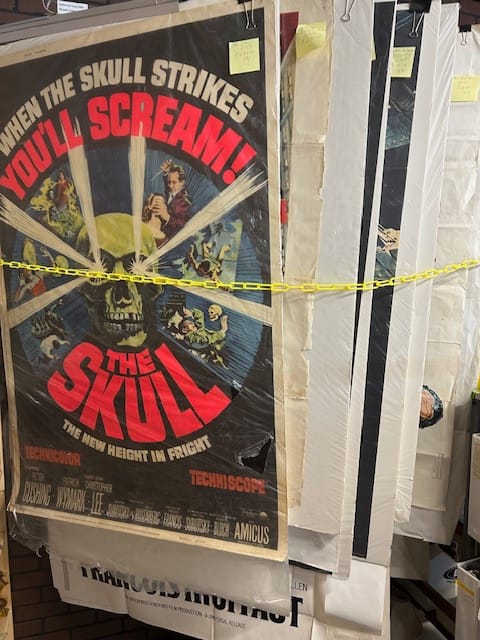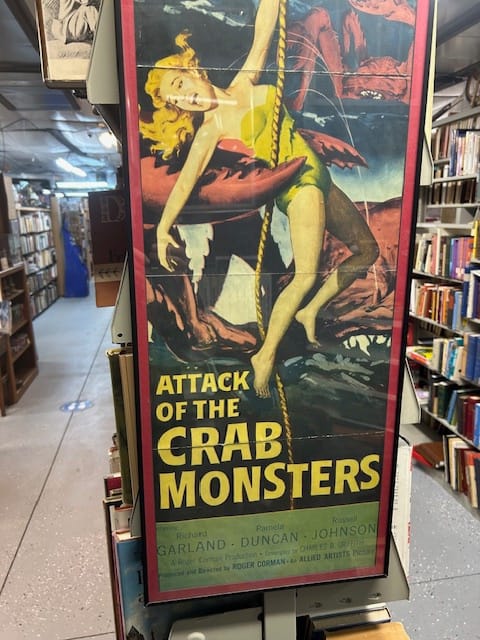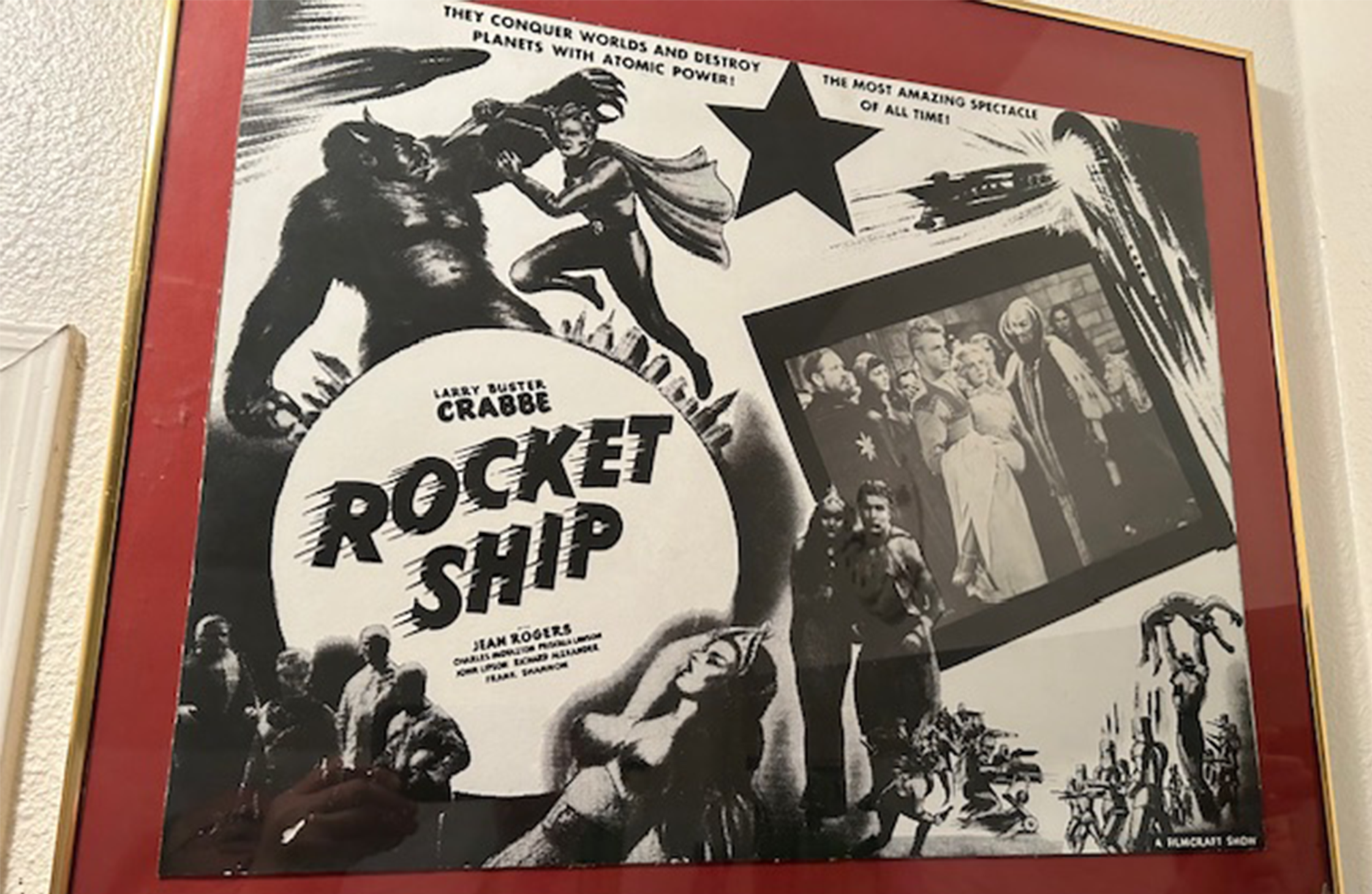Movie posters are an integral part of the memory of many movies. In 1895, the very first poster was used in Paris to promote the showing of the Lumiere Brothers' film L'Arroseur Arrosé, beginning the commercialization of moving pictures.
They became a staple of advertising for movies and continue to be used today. In the early days, they were made by studios, theaters, or promoters. They were often striking and lurid — aimed at grabbing your attention — and did not always represent the film. Although early movies were black and white, the posters were colorful and often stone lithographs. They emphasized the studio and the subject. But after the airing of The Great Train Robbery in 1903, the story began to dominate poster design.
Notably, actors and actresses weren’t displayed on posters. To control their salaries, actors or actresses were not even identified in the credits, instead emphasizing the film studio. However — in part because of Carl Laemmle’s publicity stunt where he hired Florence Lawrence, ‘the Biograph Girl,’ away from Biograph Studios — actors and actresses became more commonly identified on the posters, and their salaries began to increase.
Movie posters are intended to pique your interest and draw you in to purchase a ticket to see the movie. They are true ephemera, sent out with the movie for the sole function of advertising it. Typically, they were intended to be returned to the distributors alongside the film negative. They were often reused and frequently discarded. From 1940 to 1984 the National Screen Service (NSS) was responsible for the distribution of most movie posters for the major studios. NSS sent the posters out and expected them to be returned for reuse. As NSS phased out in the early 1980s, studios took over their poster production. Each movie’s poster had a unique NSS number set in the lower right-hand corner. The first two numbers are the year of release of the poster and the balance of the number is the NSS tracking number for the specific movie. Before 1977, there was a forward slash between the release year and the NSS tracking number, but it was eliminated in 1977.
During this period, there were other sources of printed posters, although typically not as desirable to collectors as the original issues. This includes posters from Benton Card Company, Hatch Card Company, Globe Card Company, and Realart Pictures Inc.

Movie posters were never intended to have a life beyond their initial advertising use. Until recently, they were not readily available to the public, but they’ve been of interest to collectors and individuals for personal display since their origin.
Movie posters and associated ephemera have their own set of definitions that are important in determining collectability. The size of the poster is a good metric to use to assess vintage. The primary poster size is called a ‘one sheet’ (27-by-41 inches) and was based on the size of the bed of the typical lithographic presses available at the advent of the use of movie posters. In the U.S., the Edison Motion Picture Patents Company created the General Film Company in 1908 to distribute Edison Motion’s picture films and advertising. After the dissolution of the Edison patents, various film companies set up their own distribution systems but also used the basic one-sheet size. Movie poster sizes today are generally tied to the size of these original one-sheets.
Typically, the one sheets were folded horizontally twice and vertically once to produce a folded size of about 11-by-12 inches to facilitate mailing. Most early posters — except for lobby cards, window cards, and tills — were shipped folded, while modern posters are often shipped rolled. The film distributor sent various sizes of posters to support the needs of the theaters presenting the movies, typically with the same art or sets of art. A variety of sizes were used in the U.S., from the small lobby card (11” x 14”) to the enormous six sheet (81” x 81”). More information on standard poster sizing is available at originalfilmart.com/pages/sizes-united-states. Movie posters from other countries may vary in size, and there are banners, heralds, programs, and souvenirs for movies produced in the U.S.
Lobby cards are usually sets of pictures from the movie. The lobby cards are generally sets of 8, though this varies historically, particularly for sets from different countries. They are often numbered with the first card being the title card. There are also scene cards that show the major and minor actors, and dead (or scenery) cards, which show scenes from the movie. The value is typically reflected by this order.
Stills are typically 8-by-10 inches black and white or color photographs of stars, pictures from the film, or pictures of backstage activities. The most collectible of these are the original prints issued by the film company or distributor. It is not uncommon to see people selling photographic reproductions of these stills. These reproductions are on modern photographic paper and have very limited value. Many original stills were autographed and these autographs generally drive the value of such stills.
Press and campaign books and press kits are collections of official movie posters and are also collectible. Another type of promotional piece is ad sheets (camera-ready ads), typically distributed by the theaters to provide to local newspapers and periodicals.
Movie studios also create other types of advertising, including standing posters, displays, figures, and various giveaways. Though not used in public advertising campaigns, one of the most coveted items is the storyboards used to pitch films. They are one-of-a-kind collectibles.

Other highly desired collectibles are poster variations. When a movie poster is issued with more than one set of art, there are variant styles of the poster — always an important consideration for poster value. Posters for black and white movies were typically issued in color. Some posters and re-releases of posters were done in duotone to save costs (particularly in the 1950s), often for special groups of exhibitors like military theaters. Printing substrates can also identify important variations, such as mylar and lenticular posters. Other variations include teasers (advance posters), awards posters (reissued to identify awards it received), and re-releases (typically identified by an ‘R’ in front of the NSS identification). There are even posters made to pitch a movie like the proposed 2009 movie Red Sonja, a movie that was never actually produced. Further, there are also combination posters (two movies on one poster, often as re-releases), serials, various styles (identifications on a poster where multiple formats or art was used), double-sided (printed on both sides for use in a light box), and special distribution posters (like posters for Cinerama or IMAX).
In addition to the posters produced by studios or their distributors, there are also commercial posters printed for sale to the public, video posters (to sell video tapes, DVDs, or other formats), Cable/TV posters, anniversary, special issuances, and special promotion posters (to advertise a third-party product). With the possible exception of the Cable/TV posters for their unique releases, posters not released by the studios or their distributors have limited value.
Special authorized limited-edition and artist-signed posters often have unique art that drives up value (mondo posters, Killian Enterprises, and Suncoast Movie Company). These limited-edition posters often increase in value significantly over time. If a poster is recalled after issuance, this will also tend to significantly increase its value.
The value of movie posters varies widely; the most valuable are in the several hundred thousand dollar range. Some of the highest-value posters include Metropolis (1927) ~$690,000, Mummy (1932) ~$435,000, The Bride of Frankenstein (1935) ~$330,000, Dracula (1931) ~$300,000, Black Cat (1934) ~$290,000, King Kong (1933) ~$250,000, Flying To Rio (1933) ~$240,000, and Frankenstein (1931) ~$200,000.
In general, movie poster prices fall between $20 to $200. The most valuable of the posters normally are for well-known popular movies. The price is dependent on rarity, demand for the poster, quality of the art, size, type, and perhaps most importantly condition. The one sheet is typically the basis for estimating the value of the other sizes of posters, although this may vary since half sheets fit more easily in homes. Half sheets are 65% to 70% of the one sheet value. Inserts are about 50% of the one sheet value. Window cards are about 40% of the one sheet price. Title lobby cards and the major actors' scene lobby cards are about 40% of the value of the one sheet. The full set of lobby cards is worth about the value of the one sheet. Posters larger than one sheets are typically worth less than the one sheet because they are difficult to display. The value of the stills is determined by what they are photographs of. However, the higher the value of the one sheet, the higher the value of the stills.
Most poster art is unattributed and produced in film studios or distributor’s art studios. However, some poster artists are identified on the poster like Norman Rockwell, Alberto Vargas, Bradshaw Crandall, Fred Klein, Hildebrandt Brothers, Frank Frazetta, and Boris Vallejo.
Generally, the more popular posters tend to be science fiction/horror, seminal works, film noir mysteries, avant-garde, or cult movies. Occasionally, the movie poster values can be unrelated to the quality of the movie and it’s the poster art that drives the value (e.g., Tarantula, Wasp Women, and Attack of the Crab Monsters).
Star Wars (original series) posters are popular and vary greatly in price. They range from ten to thousands of dollars. The later movie posters are valued lower than their earlier series versions. The Star Wars 1977 Style A one sheet, Star Wars 1977 Style C one sheet, and the Revenge of the Jedi poster that was withdrawn to change the title were among the most expensive Star Wars series posters and are in the thousand-plus dollar range. In 1985, Kilian Enterprises released a poster summarizing the various Star Wars series one sheets that had been issued. This poster is commonly known as the “Star Wars Poster of Posters” and is worth about $25 to $50.
Some of the most recognizable Hollywood movies have a significant range of value. Popular collectible posters are as follows:
- A few hundred dollars: Alien, Aliens, Star Trek (series)
- Several hundred dollars: Day of the Triffids
- More than a thousand dollars: Pulp Fiction
- A few thousands of dollars: Blade Runner
- More than ten thousand dollars: Jaws, Thunderball (and many of the early James Bond films), Clockwork Orange, Lawrence of Arabia
- Up to multiple thousands of dollars: Forbidden Planet, Day the Earth Stood Still
- Multiple tens of thousands to $100,000s of dollars: Casablanca
The one sheet for 2001: A Space Odyssey is typically listed in the hundreds to thousands of dollars. However, I saw the movie in Cinemax and I have never seen the Cinemax poster for sale aside from the one copy I have. The collectible value for a unique item can frequently be much higher.
Movie posters make excellent wall art, particularly in your television/theater room, and are often used in commercial facilities. The posters are available at a wide range of prices so they include posters that fit into most people’s budget. The rare high-quality poster is a historically good investment but would need to be protected and never trimmed. Note: generally, professionally backing your poster with linen does not significantly alter its value and will protect it. On the other hand, taping or gluing a poster to any other backing or a wall seriously damages its value. Pin holes, tears, and stains can have the same notable negative effect, so be careful how you attach or store them. When buying rolled posters (particularly supposed early ones), be very careful as these posters were traditionally shipped folded, and rolled posters may be fakes.
References:
Dietz, James S. Jr., Price Guide and Introduction to Movie Posters and Movies Memorabilia,1985.
Poole, Edwing E. & Susan T., Collecting Movie Posters, An Illustrated Reference Guide.
Hensiek, Sebastian, Most Expensive Move Posters: A Collector’s Guide.
Warren, Jon R., Warren’s Movie Poster Price Guide, Overstreet Publications Inc., 1986.
Poole, Ed and Susan, Learn About Movie Posters, IGuide Media Inc., 2002.
theguardian.com/film/gallery/2012/mar/14/10-most-expensive-film-posters-in-pictures
justcollecting.com/blogs/news/the-most-expensive-movie-posters-of-all-time
Steven Woolfolk is the owner of Xenophile Bibliopole & Armorer, Chronopolis, a rare books specialty bookstore in Richland, online at Xenophilebooks.com.
For more information, explore the links referenced in this article, or visit your friendly local bookstore:
XENOPHILE BIBLIOPOLE & ARMORER, CHRONOPOLIS
2240 Robertson Drive, Richland

